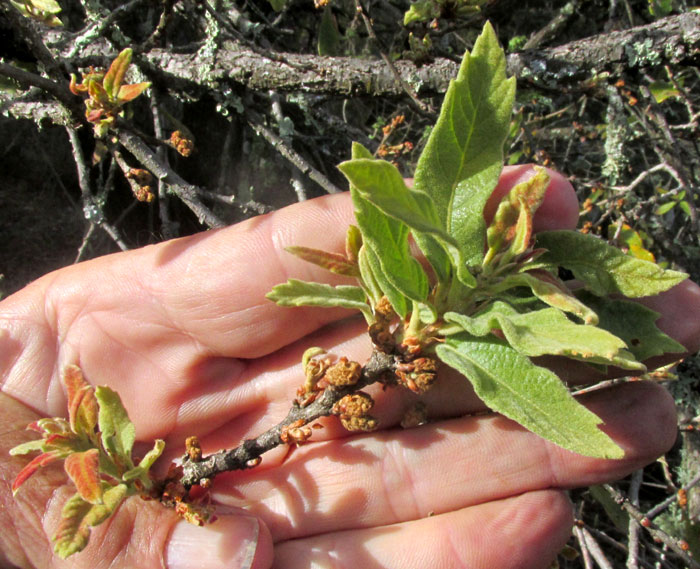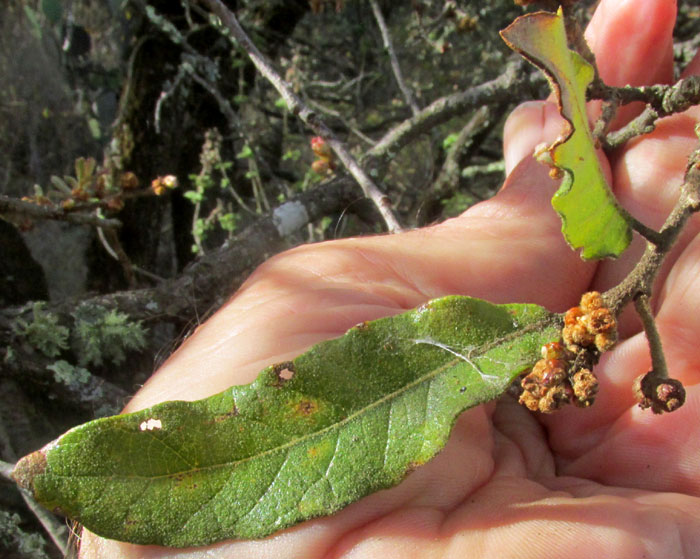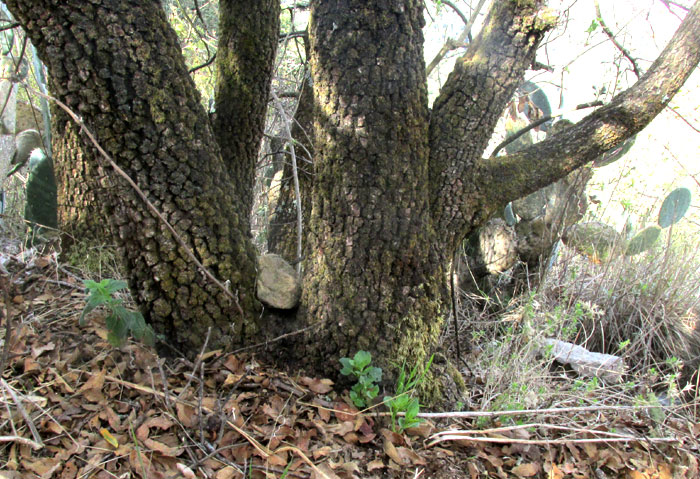Excerpts from Jim Conrad's
Naturalist Newsletter
entry from field notes dated July 29, 2022, taken in an oak forest atop Cerro de la Cruz, elevation ~2885m (~9465 ft), rising on the south side of the community of El Pinar, Amealco de Bonfil, Querétaro, MÉXICO, (~N20.17°, ~W100.17°)
QUERCUS DESERTICOLA

Atop a narrow, windswept ridge maybe 15m below the peak of Cerro de la Cruz, nearly all the trees were Netleaf Oaks, Quercus rugosa, with a few tree-type pricklypear cacti, Opuntia streptacantha, but just as the ridge's western slope began dipping into the valley, forming a little shelter from the wind, a single other oak tree species appeared, a low but widely spreading one with multiple trunks. It was practically leafless, but some branches were beginning to sprout new leaves and flowers, as shown above. Even at this early stage of development it's seen that most leaves have a few sharp teeth at their outer ends, though some bear no teeth. In fact, here's one of the tree's few leaves remaining from last season, bearing no teeth at all:

Mature leaves on this tree are small and narrow, willow-like, and with scattered short hairs on the surface. The Flora del Bajío describes the hairiness as -- "tricomas fasciculados cortos estipitados" -- but without magnification you can't make that out. A leaf's very hairy undersurface is shown below:

Note that the blade margins are narrowly but thickly rimmed and somewhat turned under. Also, last season's woody stem retains a dense cover of pale, close-lying hairs. Beneath the tree the cups of last season's acorns were easy to find, but no nuts:

The Flora del Bajío says that the cup covers about a third of the nut. My impression is that a relatively high percentage of acorns are aborted before they grow much. Below you can see the tree's several trunks and black, blocky bark:

All these traits and more bring us to QUERCUS DESERTICOLA, an oak tree endemic just to the uplands of central and southern Mexico from here in the Querétaro/ Hidalgo/ Guanajuato area south to Puebla state. I can't find it listed as existing higher than 2800m, but here we're a little above that, apparently at the tree's upper limit. The species is described as abundant in certain areas of oak forest, plus it's found in disturbed situations, indicating a certain ecological flexibility.
The species appears to have no common name just for itself, either in Spanish or English, other than those generally used for any number of other oak species.
Predictably, it's said to be used for firewood, charcoal-making, fenceposts, and such. In fact, only botanists seem to have noticed that here's a distinct species with looks and habits different from the other 150 or so oak species found in México, or even the ~45 species occurring just here in the Bajío region of central Mexico.
So, I'm particularly glad to celebrate on this page this species' ability to grow above 2800 meters in elevation, and the leaves' short bundles of stalked trichomes, even though they're hard to see.